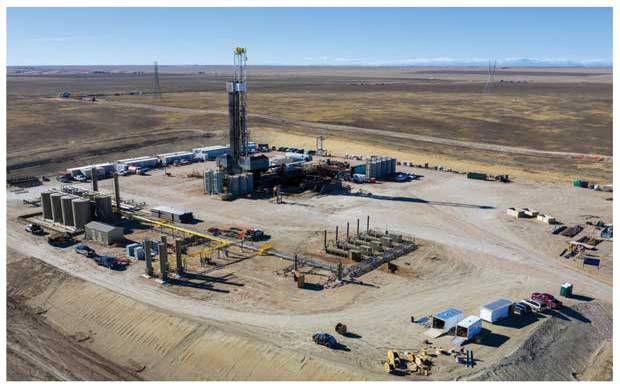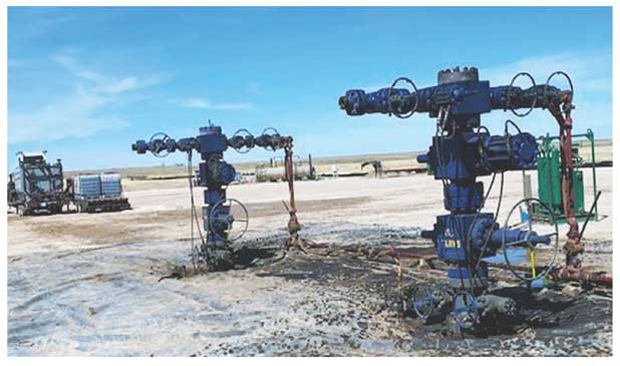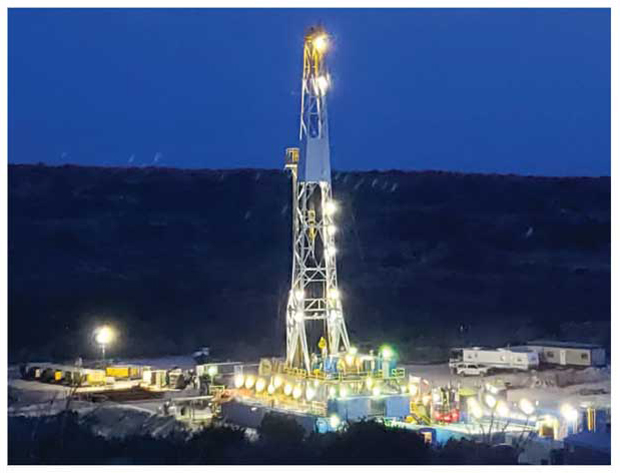
Industry Activity: The Producers
Winning Big Time With New Discoveries; Development Projects
By Tim Beims
As the industry slowly restarts the engines of drilling and completion activity, many of the same companies that were quickest to respond last spring to collapsing market conditions are among the first taking steps this fall to get back to the business of developing new reserves. In many cases, the early movers are the smallest players in the game: private independent oil and gas companies.
From the Rockies to South Texas, small independents are proving that scale isn’t everything; they are differentiating themselves with low-cost structures, adaptable business strategies, outside-the-margins thinking, innovative applications of technology, and high-quality leaseholds.
A case in point is Bison Oil & Gas II, headquartered in Denver. In August, Bison announced the results of the four-well Boomslang A and B pads in its Baja area in northeastern Weld County, Co. The Boomslang drilling unit is composed of seven mid-reach (~7,500-foot) laterals and one extended-reach (~10,000-foot) lateral. With laterals lengths averaging 7,700 feet, David Gonzales, president and chief operating officer, says the eight wells on the two pads produced at an average daily rate of 625 barrels of oil equivalent over the first 180 days from the Niobrara and Codell formations.
“The Boomslang wells are significantly outperforming offset wells in the area,” remarks Gonzales. “We are very encouraged by the production results, and by the fact that we were able to drill and complete these eight wells for less than $5 million apiece on average. The economics are very favorable, even in a lower-oil price environment.”
Those results did not occur by happenstance, Gonzales assures. They represent the outcome of a strategic approach of “designing the Baja project the right way from day one,” he asserts. “It starts with the geology in our Denver-Julesburg Basin lease position. The Baja area is characterized by high-liquids production, high porosity and resistivity rock, and substantial oil in place in multiple benches of the Niobrara. It has some of the best ‘oily’ wells in the D-J Basin.”
Technology-Based Approach
Bison II’s technology-based approach to developing the assets incorporates everything from statistical algorithms to soluble chemical tracers, and encompasses optimizations across the entire value chain–from drilling and completion operations, to electrified well pads for production operations and two-way infrastructure connectivity that takes away oil, liquids and produced water while delivering freshwater to pad fracturing sites.
“All of these things, along with the quality of the reservoir on our acreage position, make Baja one of the most economic areas in the D-J,” Gonzales enthuses. “At oil prices in the mid-$40s, we expect to deliver returns on the order of 30-40%.”
Bison II holds ~25,000 net acres in Baja and has identified 111 remaining operated drilling locations in the area. It has another ~10,000 net acres of inventory in its Cartwright area offsetting Baja. “The Niobrara/Codell at Cartwright shows similar productivity with a similar high-liquids production profile. It is good stuff, too,” he remarks.
With Boomslang A and B on line, Bison II is turning its attention in Baja to completing eight new wells on its nearby Hale pad, where Gonzales says well costs are expected to average even less than on the Boomslang pads. Drilling was completed on the Hale wells by the end of the third quarter, and he reports that frac crews were scheduled to move onto location in November to begin completions.
Since entering the Niobrara/Codell in 2016 with a private equity commitment from Carnelian Energy Capital, the company has brought a total of 22 wells on line, excluding the eight Hale pad wells now underway. Once the Hale wells are completed, Gonzales says Bison II is considering drilling and completing additional wells in Baja over the first part of 2021, assuming oil prices continue to stabilize.
The eight wells on Bison Oil & Gas II’s Boomslang A and B pads in its Baja area in northeastern Weld County, Co., produced at an average rate of 625 boe/d per well over the first 180 days of production from 7,700-foot average lateral lengths. The four wells on each pad were alternately landed in the Niobrara B and C benches at 640-foot spacing and completed at 180-foot stage spacing using 2,300-2,500 pounds of 40/70-mesh sand and 43-50 barrels of slickwater per lateral foot. The company has since drilled eight wells on its nearby Hale pad using the same approach, and is preparing to commence completion operations.
Apart from the trend-setting performance on the Boomslang pads, Bison II’s approach is confirmed by its nomination for the second consecutive year as a regional finalist for Ernst & Young’s entrepreneur of the year award. “We’re proud to have been nominated in back-to-back years,” Gonzales states. Bison II is the only operating company to make the list of 20 nominees.
Draining The Tank
Each Boomslang pad was developed using 640-foot spacing between each “one-and-a-half mile” lateral. The mile-and-a-half wells took 4.5 days to drill on average using conventional directional tools (average drilling times were reduced to just over 4.0 days on the succeeding Hale pad). Each 7,500’ lateral was drilled alternating between the Niobrara B and C benches, which together contain the majority of oil in place in the Niobrara/Codell geologic system, according to Gonzales.
“We believe fracture heights from wells landed in the Niobrara B are capable of growing upward into the A bench. Conversely, fracs in wells completed in the C tend to grow downward and drain anything between the C and the Codell below,” he explains. “From our perspective, this is the most efficient way to drain the entire ‘tank.’”
To investigate and quantify lateral spacing and frac growth, Bison II conducted field tests with soluble chemical tracers added to frac fluid at lateral spacing intervals as tight as 440 feet, which is the equivalent density of a 12-well drilling unit. The tracer diagnostics work was performed by NCS Multistage Tracer Diagnostic Services. Gonzales says the insights from the empirical testing were applied in designing the Boomslang pads.
“We did not see any significant well-to-well interference during fracturing nor production operations,” he reveals. “That gave us confidence that we would effectively stimulate the rock volume between wells at 640-foot spacing on Boomslang A and B, but not create any detrimental impacts by having the fracture networks collide. The production results indicate that is indeed the case on both Boomslang pads.”
Liberty Oilfield Services pumped the fracturing treatments for the Boomslang B pad, and Halliburton pumped the treatments for the Boomslang A pad. The wells were completed at 180-foot stage spacing using 2,300-2,500 pounds of 40/70-mesh sand and 43-50 barrels of slickwater per lateral foot.
Of the average 625 boe/d per well initial 180-day production output, 88% was oil with another 4% in high Btu-content natural gas liquids, Gonzales reports. “In the core of the D-J Basin, you see gas-to-oil ratios as high as 10 Mcf per barrel. For Baja, it is more like 2.5 Mcf per barrel of oil, and the liquids are premium. The gravity of the oil is 38 degrees API, compared with about 50 degrees in the core of the D-J, which means our oil trades at a higher value. The Btu content of the gas also is higher at 1,400-1,500 Btu.”
Bison II maintains a midstream joint venture with Taproot Energy Partners to gather its produced liquids (including produced water), as well as supply freshwater to well sites. “We have built out a large infrastructure system, including midstream and pipeline facilities and electric service to all our pads,” Gonzales comments. “This helps give us a materially better cost structure.”
Big Plans
In the northern reaches of Weld County, a stone’s throw from the Wyoming border, another small private operator–Boerne, Tx.-based Upland Exploration LLC–achieved an historic first last spring when it brought its first 100% operated well on line. But the Little Lady No. 22-1NH wildcat made history for another reason, according to President David R. Watts: the highest 24-hour peak oil rate per completed lateral length for any 4,000-foot or longer D-J Basin horizontal well drilled over the past decade.
Designed as a “one-mile” lateral with a completed length of 4,883 feet, the 22-1NH produced 1,396 barrels of oil equivalent per day on a two-stream basis (82% oil) from the Niobrara B, the equivalent of 285 boe/d per 1,000 feet of completed interval. “This well is as good as any in the basin per 1,000 feet of lateral,” Watts reports. “The excellent productivity with a high oil cut and increased estimated ultimate recovery is corroborated by extensive geological data, suggesting the results are repeatable across our position. We have lots of big plans for the area.”
The No. 22-1NH on Upland Exploration Inc.’s Little Lady South pad–the company’s first 100% operated well–came on line producing 1,396 boe/d (82% oil) from the Niobrara B, ranking as the highest 24-hour peak oil rate per completed lateral length for any 4,000-foot or longer D-J Basin horizontal well drilled in the past decade. With a completed lateral length of 4,883 feet, the 22-1NH was drilled with a rotary steerable system and used an “engineered” completion design with diversion on each stage. Upland Exploration is preparing to drill the first two of seven planned wells at the adjacent Little Lady North pad–both 100% operated one-mile laterals.
Upland Exploration holds 27,000 net acres in Weld County and across the state line in Laramie County, Wy. The 22-1NH is on the Little Lady South pad, which like its sister pad, Little Lady North, is being developed with seven wells. The first two of the seven planned wells at the north pad both–both one-mile laterals 100% owned and operated by Upland–are scheduled to commence drilling operations by the end of November targeting Niobrara benches.
“We are greatly encouraged by the performance of the 22-1NH well, and are excited about developing the Little Lady blocks and the rest of our lease position,” Watts offers. “We have probably 300 Niobrara/Codell well locations in our 100%-owned, tight-knit block.”
The 22-1NH was the first well drilled on the south pad, and was subsequently twinned with the Little Lady 22-2CH in the Codell underlying the Niobrara. The 22-2CH came on line at a 30-day IP of nearly 400 boe/d. “When you have a well that is producing 1,396 boe/d from one formation and one that is making 400 boe/d from another, your concentration shifts pretty quickly to the big boy, and that is what we are doing,” he relates. “The remaining wells on the south pad, all one-mile laterals, will be landed in the Niobrara.”
Staying On Track
The Little Lady 22-1NH was drilled with the Baker Hughes AutoTrak™ rotary steerable system. It was stimulated with an “engineered” completion on 220-foot stage spacing using 1,800 pounds of proppant and 2,200 gallons of fluid per foot with Thru Tubing Solutions’ SlicFrac™ diverter “pods” on each stage. Crescent Consulting LLC in Oklahoma City assisted Upland Exploration in designing and managing the drilling and completion operations, which were conducted by Savanna Drilling and Liberty Oilfield Services, respectively.
James Jackson, senior project manager at Crescent Consulting, says RSS helped the team keep the laterals in the target zone from heel to toe. The 22-1NH was drilled in five days and the 22-2CH took four days. “We weren’t trying to set drilling records. The key to getting a good wellbore is using 3-D to plan the lateral and then using drilling data to steer through the formation as designed,” he explains. “It is easier to stay in zone with an RSS, and both of these wells stayed in zone 100% of the time.”
The 3-D seismic dataset over the Little Lady blocks is part of a reprocessed survey from Seitel’s library and covers Upland’s entire D-J Basin leasehold, according to Watts. The B is the thickest of the Niobrara benches, but is still relatively thin as shale formations go at 20-40 feet across northern Weld County. It is also geologically complex, with significant natural fracturing. “The 3-D is important to mapping the benches, and you need to drill with the wellbore spot-on where you want it,” he relates.
Mining More Rock
The 22-1NH’s completion was designed with 48 perforations per stage and higher concentrations of fluid and sand volumes, with diversion to propagate fractures more effectively and maximize reservoir contact. “Instead of a limited-entry design, we decided to perforate more holes and run Thru Tubing Solutions SlicFrac diverter,” Jackson states. “During treatment, pressure data showed we were getting really good diversion. We think this allowed the stages to mine more rock. Mining more rock means accessing more oil, which is probably a big reason why the well is so productive.”
The enhanced productivity is in keeping with Upland Exploration’s contention that Niobrara wells in the area have been understimulated in the past. “For my small shop, I relied on our geologist, Tom Taylor (managing partner at Owl Creek Exploration in Fort Collins, Co.), and Crescent Consulting to optimize the completion design,” Watts remarks. “I think the 22-1NH shows the effectiveness of utilizing a modern high-intensity design and on-the-fly adjustments.”
During treatment, the team made real-time changes to the base design to enhance effectiveness all along the lateral as pumping progressed. “We were able to very quickly make changes based on what the formation was giving us at each stage,” Watts says.
Jackson adds, “We monitored diversion drop pressure responses. Seeing good pressure responses on the diversion drop told us we were initiating new fractures and treating new perforations and accessing more rock.”
One of the major changes was switching to smaller-sized proppant. The treatments for both the 22-1NH and 22-2CH were designed to pump 30/50-mesh sand with 100-mesh tail-ins. “Larger sand provides better conductivity, but we realized after the first few stages on both wells that the formation was not liking the 30/50, so we changed to 40/70-mesh sand,” Jackson recalls. “We also did not pump as much 100-mesh as many offsets in the area.”
The 22-1NH is equipped with an electric submersible pump, but a higher-than-expected gas-to-oil-ratio has led to frequent gas locking and downtime, Jackson reports. Consequently, after five months on production, Jackson says work was planned to replace the ESP with a gas lift system.
“The well is making more gas than other any other Niobrara well in the area, which is a good problem to have. Even with all the ESP downtime, it is producing 250-350 bbl/d of oil and has a high fluid level,” he observes. “Changing the artificial lift method to gas lift should be a much more efficient way to produce the oil, and will hopefully get production back to the 500 bbl/d range.”
Whether the drilling, completion or production processes, Watts says Upland Exploration will seek to optimize results going forward as it drills the remaining one-mile laterals on the Little Lady pads and spuds its first two-mile laterals on its acreage, tentatively expected by mid-2021.
“We started in 1998 as a nonoperator with very small interests in wells in the western Anadarko Basin. We couldn’t have asked for better results on our first 100% operated well,” Watts concludes. “It is a great starting point, but we will continue to make step-change improvements in performance throughout the development of the Little Lady pads, and ultimately, our broader position in the area.”
New Gas Discovery
In Southwest Texas, in the long shadows of the tight oil resource plays in the Permian Basin to the north, Barron Petroleum LLC is quietly ramping up a program to develop a new condensate-rich gas discovery in the Val Verde Basin that President and CEO Manjit “Roger” Sahota calls a “company maker.”
Barron announced the discovery in August after successfully drilling the Sahota Carson 20BU No. 1 late last year and subsequent delineation wells this year targeting the Strawn formation. The company’s original 13,000-acre Val Verde County leasehold, located to the southwest of the Massie Field that has produced some 160 billion cubic feet of gas from the Strawn, is estimated to hold reserves totaling 417 Bcf of gas (74.2 million boe).
“We are a small ‘mom-and-pop’ company. It is me, my wife and our three sons, so this discovery is huge for us. With strengthening natural gas prices, we intend to continue an aggressive drilling and development program,” Sahota says.
Since the delineation drilling to confirm the discovery, the Graham, Tx.-based company has nearly doubled the size of its lease footprint by acquiring another 12,000 acres, according to Sahota. Over the next 12 months, he says Barron plans to drill at least 40 vertical wells in the project, in which the company holds a 100% working interest.
Sahota’s path into the Val Verde Basin is a long and winding one. He began his career in construction, eventually establishing his own firm building homes and apartments in Canada and then in California and Colorado. That eventually led to starting a land development business on 640 acres in Colorado. After oil and gas were discovered on the property in the early 2000s, Sahota’s business found itself in energy development, drilling in the Rockies, Canada, Louisiana and Texas.
“We now have production in Stephens, Palo Pinto, Schleicher and Wichita counites in Texas, but Val Verde County is the biggest asset we have ever had,” Sahota says. “We knew with the 20BU No. 1 that we had hit big time, but it has been amazing to see our geologic model proved up by drilling.”
Drilled to a total depth of 12,650 feet, the vertical discovery well penetrated 70 feet of gas-bearing Strawn. Following acid stimulation, the well tested at 5 million cubic feet a day. The company has identified more than 70 high-graded Strawn locations on its initial 13,000 acres alone, which also is prospective for the Canyon above the Strawn and the Ellenburger underlying it.
A Big Thing
The Sahota Carson 20BU No. 1 was one of several potential Strawn drilling locations identified from 3-D seismic data analysis by William J. Purves, president at Dallas-based Highlander Energy LLC and a consulting geoscientist. Presented with multiple options, Sahota says he asked Purves to select the single most prospective location to drill the first test well.
“Dr. Purves picked out the 20BU. We cut the pad and started drilling, hoping to see gas below 12,000 feet. But the closer we got to 12,000 feet, the slower the rate of penetration. We were averaging four feet an hour at one point. I was so frustrated. I was worried about how much money we were spending every day,” he recounts. “I called Purves and he told me that was normal. We were in a hard rock cap, but that once we got through it, ROP would jump. A little later, the driller called and said the bit had drilled 200 feet in a very short time and that pressure was starting to build. We knew we had the formation at that point.”
Barron Petroleum is ramping up a drilling program to develop a condensate-rich gas discovery in the conventional Strawn formation in the Val Verde Basin in Texas. The Sahota Carson 20BU No. 1 discovery and offset delineation wells were drilled on Barron’s initial 13,000-acre Val Verde County leasehold, which is estimated to hold reserves totaling 417 Bcf of gas (74.2 million boe). The company has since acquired another 12,000 acres in the area, and plans to drill at least 40 vertical development wells in Val Verde County over the next 12 months. Barron Petroleum holds a 100% working interest in the project.
The structure the well had penetrated was exactly as the 3-D model had predicted, including the gas and condensate reserves. “I called Purves. He said, ‘I told you!’ My family was so excited. We all started celebrating,” Sahota recalls.
More celebrations were to follow, starting with the BU19 confirmation well, which repeated the same scenario of slow ROP followed by a rapid increase as the bit reached the Strawn. Another delineation well also found pay, further confirming the geoscientific model.
Barron hired Albert McDaniel, a consulting petroleum engineer in Flower Mound, Tx., to evaluate the project’s upside potential and appraise the reserves. “He estimated that we had 417 Bcf on the original 13,000 acres. He also said the drilling risk is low enough that we should consider it is more of a development (as opposed to an exploration) project,” Sahota states. “That makes it even better.”
Barron maintains its own fleet of drilling and workover rigs capable of working to depths of 20,000 feet. As it continues to drill new wells to develop the acreage, Sahota says the company is constructing a gas sales line to Enterprise Product Partners’ nearby pipeline connection at Johnson Draw. The condensate gives the produced gas a premium valuation, maximizing development and production economics, he notes.
“This discovery is a big thing to my company. It’s a big thing to my family. It’s also a big thing to our employees,” Sahota concludes. “We employ about 130 people. We owe our success to them. We have always paid our people top wages and salaries, and this opportunity in Val Verde County will let us continue to do that for a long time to come.”
For other great articles about exploration, drilling, completions and production, subscribe to The American Oil & Gas Reporter and bookmark www.aogr.com.


















